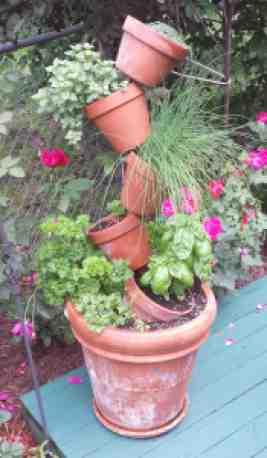Growing Herbs & Veggies in your Flower & Shrub beds

Hello again everyone, this is Ann & Chris from Growing Trends – you can listen to our podcasts at Growing Trends
Yesterday we started a new series of Growing Herbs & Veggies in a variety of easy ways at home, rather than the more traditional row crop method.

Just to recap they are :
1. Introducing Herbs & Veggies to an existing flower or shrub bed.

The Herbs & Veggies blend in and are almost invisible to the untrained eye.
2. Growing Herbs & Veggies in a container.

Growing in pots is great for those with restricted or small spaces. There are a few extra considerations you need to take for success, which we will explain.
3. Square Foot Garden
- created by Mel Bartholomew, square foot gardens are one of the most efficient ways to grow your herbs & vegetables
4. Traditional ‘Allotment’ or ‘Community Gardens’

Allotments are particularly European ,
in Denmark they date back to 1778, in 2001 there were around 62,000 !
Finland started around 1916,
France, Czech Republic, Germany, Holland, Norway, Sweden, Poland, Russia, Portugal, England, all have long traditions of ‘Allotments’
Community Gardens are more an American version, which often started as a ‘Victory Garden’ in the second world war, and has developed into a Community Garden.
So lets start today with.
1. Introducing Herbs & Veggies to an existing flower or shrub bed.
There are usually lots of different places where you could insert herbs and veggies in an established garden, the secret is to work with the design.
A good time to find those elusive spaces is now as you start your spring cleaning of beds.
Remember to think about the plants final height, most will require at least 6 hours of sunlight
How often you will need to get close to the plant to gather the crop.
Check regularly for pests and diseases and to feed & water.
Use low growing herbs, colourful cabbages instead of annuals for instance
Remember to add compost to the soil as they will still need nutrients
Place taller growing herbs and vegetables with taller shrubs towards the back of a border
With the lower growing herbs and vegetables towards the front of a border.
Remember flowers like Nasturtiums, Pansies,Orange blossom,Squash flowers and Marigolds are edible ( but not if they have pesticides sprayed on them) – take a look at Eat your Roses for more ideas
You can add Squash, Tomatoes, Eggplants,Lettuce, Cabbage, Peppers, Cucumbers, Rosemary, Marjoram, Oregano, Parsley, Basil, Sage, Thyme, Strawberries, Blueberries, Radish, Onion, Swiss chard, Apple, Cherry, Plum, etc.,
Remember to feed regularly .
There is no need to ‘row plant’ be creative.
Now you can visually enjoy as well as enjoy eating.
You can listen to more great ideas on our Podcast at Growing Trends
Tomorrow we will talk about growing herbs & veggies in containers.
Chris & Ann are landscape designers, gardeners, inventors , radio show hosts, we live in the MidWest , are passionate about food, cooking, wine and love to interview people who share our passion for the environment.
We would love to hear from you …
Views: 12









